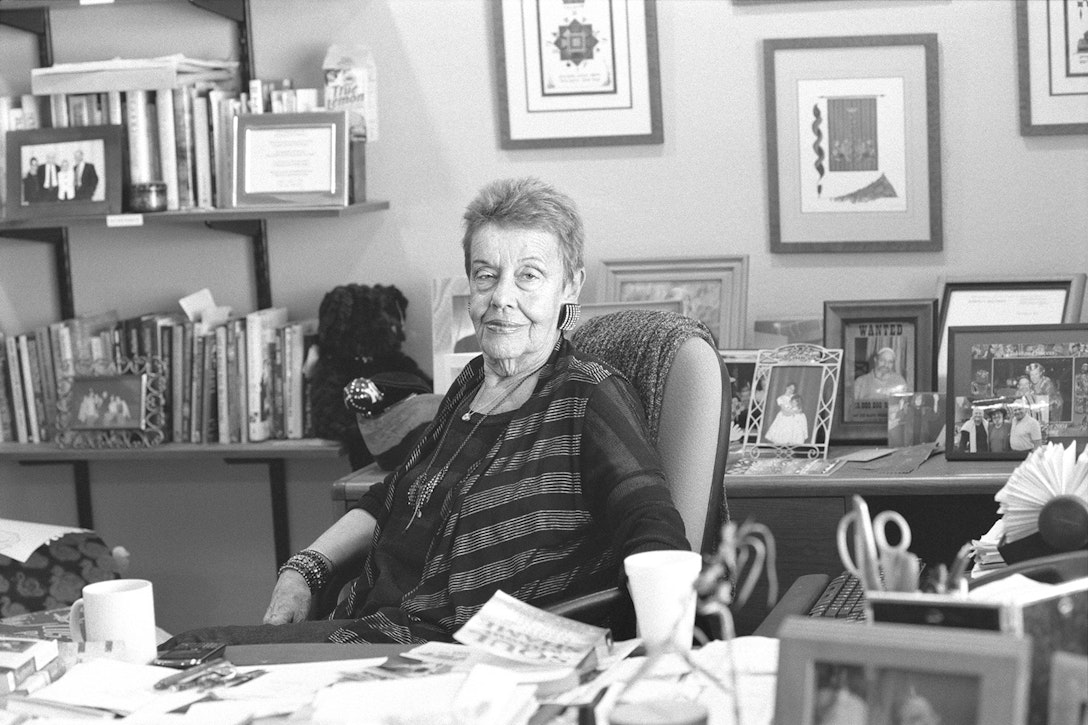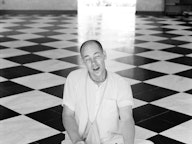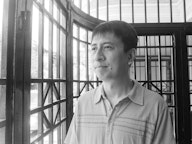
Harriet Rossetto
Los Angeles, California, USA
I WANT TO KNOW WHAT I WANT
A lot of my life was spent feeling empty and dissatisfied and negative. Life is hard and then you die. I was a young mother in the 1960s. I was part of that whole movement, and never found how to put my pieces together. They were always at war with one another; my inner parts. I didn’t have [faith] for a very long time. Or at least I had faith only in negative things. My faith was that nothing good would happen and that you could always count on being disappointed.
And when that changed was the whole way in which I found the calling, when I went to see this woman who was a metaphysician; a Science of Mind lady. And I was at a really down place; a bottom in my own life. I had no idea what to do. I’d left social work. My one child had gone off to college, and I thought, ‘Well that’s it, there’s nothing more for me.’
So before I decided to kill myself I went to see this lady and she said, ‘What is it that you want?’ And I never sought any kind of spiritual help. I considered myself an atheist, at least an agnostic, a cynic, a skeptic; this was not for me, but I was pretty desperate. And she said, ‘What do you want?’
And I said, ‘Well, that's my problem. I don’t know what I want. What I want is I want to know what I want.’
And she said, ‘Do you pray?’
I said, ‘Lady, come on.... Pray? You know, I'm an intellectual, I’m a Jew, I, I never prayed in my life.’
And she said, ‘I’m going to pray for you. Father of the universe, take this woman by the hand and guide her to her rightful work. She knows she wants to do something to make a difference. She doesn’t know what it is.’ Then she said, ‘That’s it. Now you pay attention.’
A little hokey, but I was unemployed and I was looking in the want ads. And I had left social work, I wanted to do something else; make a lot of money. And something said to me, ‘Well why don't you see what social work has to offer?’ And, in retrospect, that was the still small voice I think.
So I looked and there was this tiny little ad. It was the smallest ad on the page and it said, ‘Person of Jewish background and culture to work with Jewish criminal offenders.’ And that was my moment. Every time I retell it—and I’ve retold it a lot over the years—the hairs on my arms stand up with what they call in the program ‘God bumps.’ And I thought, ‘Oh shit! You know? This is it! And this worked! This worked.’
I made a very rational decision to call that [a] Divine calling; to call that a moment of faith. This woman prayed for me and I was guided, and it was mine. This was it, what I had been searching for. And that changed everything for me.
So I read the ad and I went down for the interview. And when you go with the surety that comes from knowing you’ve been divinely sent, you present yourself in a certain kind of way. And I didn’t tell them I was divinely sent ’cause it was a mental hospital; I didn’t want them to lock me up!
And they hired me. And I started visiting Jewish people in jails and prisons. And I was hooked from day one. These were my people. I saw myself as the translator; the person who knew them and identified with them, but who was from the right side, and could translate.
And there was nowhere for people [to go] when they came out. So I got this notion to start a place. A Jewish home where people could come when they got out of jail or prison, and re-enter life and heal from their addictions. So I wrote a grant for a one- time purchase and we bought an old house down near the barrios. It was part of a mental health complex called Gateways Hospital. And I had no operating budget, and no staff, so I moved in.
And that was it. That was almost 25 years ago. And in the course of things I met Mark, my husband, who was then an inmate in the state prison. He is now a rabbi and we do this together. And we built a community, and a family here, really. A place where I feel connected. I had never felt connected anywhere. I always felt I didn’t belong in the worlds in which I found myself. So this is my place, too.
The faith I have today is that...not that if I’m a good girl, good things will happen. I know that’s not so. But the faith I have is that whatever hand I’m dealt, or whatever I need to deal with, I will also be given the strength and the support to deal with it. I believe that.
Daniel’s Reflection
Harriet Rossetto thought she might as well kill herself when her daughter left home, when she became disillusioned with her social work career and felt aimless. A last ditch effort for guidance came when she visited a Science of Mind practitioner who asked her, “What do you want?” And, like so many of us, she responded, “I don’t know what I want. I want to know what I want!”
The Science of Mind practitioner prayed for Harriet and told her to pay attention. While she had sworn off social work, she looked at the want ads and saw a listing for someone to work with Jews in the California State prison system. And her soul was lit on fire for the calling she didn’t know she had, but it felt so right.
Harriet went on to found Beit T'shuvah, “a unique community that empowers individuals and families to live meaningful lives through spirituality, psychotherapy, the 12-Steps, and Jewish teachings.” One of the inmates that Harriet worked with, Mark Borovitz, came to work at Beit T'shuvah as an ex-con, then became both her husband and a rabbi who ran Beit T'shuvah with Harriet for over 25 years. So, as Harriet says, this is also a love story.
I went to Los Angeles to interview Rabbi Mark because of his profound book, The Holy Thief: A Con Man's Journey from Darkness to Light. He suggested I also interview Harriet. Her interview has become one of my top few to share from the entire project. Harriet’s profound statement, “I want to know what I want,” speaks to the person I was 20 years ago, and for so many people today.
Why is this question so pervasive when we have more opportunities and resources available to us than probably any other generation or civilization in the Earth’s history? “I want to know what I want” signals that our lives are clouded with tasks and obligations that don’t feed our true spirits. For some, it can be because they are in survival mode. For me, it was for many years because I wanted to be important, and because I wanted to make enough money that no one could control me (which in itself is a fallacy since I either allow or don’t allow that to happen).
Today, I have found peace as a teacher, an artist, and a healer. My teaching just happens to be in the business realm where I create and implement new marketing models based on science for companies and organizations. My journey with Portraits in Faith allowed me to be an artist (photography) and a healer. As I share stories of faith from around the world, it enables others to have a voice, to be heard, to promote healing.
So what lessons does Harriet Rossetto’s interview provoke in me to share? What have I learned from my own journey that might help others who want to know what they want? Here are various tools I’ve used on my journey, starting with the one that worked for Harriet: Prayer, Examining My Beliefs and Values, and, Doing the Next Right Thing:
Prayer: Prayer for me mainly means humility; not asking for something specific. When the Science of Mind practitioner prayed for Harriet, she said, “Father of the universe, take this woman by the hand and guide her to her rightful work. She knows she wants to do something to make a difference.” The prayer was not for a job that would earn her a large salary or be located in a certain city. It was to help her make a difference.
And when my career was not going in a clear direction, I prayed to be of service to God and the Universe. Just to be of service. Funny enough, my go-to thought in my 20s and early 30s when work was not going well was that I should become a rabbi. In retrospect, thank God I did not because that would have been theologically too limiting for me and not a personality fit (even though I still identify as and love being Jewish). I struggle with prayers for specific things such as have been made popular through “prosperity gospel” or “prosperity religion.” I believe the only prayer I can authentically offer is, “Please use me to better the Universe and all of humanity and creation while I am here on this Earth.” Like many, I tried to analyze my way into “what do I want” and it never worked by itself. Prayer has been the driver of my journey into realizing my purpose.
Examining My Beliefs and Values: My friend and colleague, Matt Carcieri, developed a world-class approach to determining a brand’s purpose and I find the same exact approach can help individuals with a life purpose. Matt directs us to write down our beliefs, especially those that can provide the most guidance. For example, some of my most important beliefs are: “There is always room at the table,” and, “There is no ‘other’ / there is no stranger / we are all spiritually connected and responsible for each other.” Matt further suggests we list our most important values, which for me would be “inclusion,” “agape—deep spiritual love,” “ justice,” and “connection.” The process concludes with creating a statement that starts with: “I exist to….” In my case, it would be something like: “I exist to bring together others in a deep understanding that we are all partners in creation and God’s holiness.”
For advanced students, Matt directs us to develop “acts” that only someone with these beliefs, values, and purposes would take on, such as publishing a photo/video documentary of about 500 people in 27 countries celebrating the diversity of spiritual journeys, or producing a series of interfaith concerts for protection and healing during the COVID-19 pandemic. A variation on this process to identify your purpose would be the excellent advice I heard which is to not ask kids what they want to be when they grow up but ask them, “What problem do you want to solve in your lifetime?”
Doing the Next Right Thing: In my 20s and 30s, I kept thinking that at each crossroads I needed to make the perfect decision or the rest of my life would be a failure. Now I better understand that I just need to make the next best decision at the time. Coming out of undergrad work, that decision was to be a CPA in a Big Eight accounting firm, even though I now refer to those five years as “when I was a miserable CPA!”
And then the next best decision for me was to get my MBA at a top school, inspired by my friend Ruth Lillian Reiner. Then I really did not want to go to Procter & Gamble full-time, but I agreed with my friends that I would go for one year then decide. Around five years into P&G, I was not doing well in my career there and was hitting various walls in the first level of management. I thought about becoming the head of marketing for the Reconstructionist Movement of Judaism, but it did not feel like the right move (and I was told I would not be able to date the rabbinical students!). I wanted to get better at the things my managers at P&G said I needed to improve upon. Around year eight at P&G, I got to focus on global strategy, innovation work, and researching/teaching new marketing approaches. It felt right, and the feedback I was getting was more and more positive.
And now, seven years post-P&G, I am running my own consultancy and working on Portraits in Faith. So I consider my journey to have been a series of iterative decisions, none of which I could have or would have wanted to predict. The same is true of my spiritual journey which started with deep involvement in my synagogue and Jewish community, but has expanded to interfaith work and now this very broad platform for honoring the sacred in all walks of life and in all aspects of humanity. Additionally, Portraits in Faith could have never been created had I not been in the global strategy and innovation roles for P&G.
Even my marriage was the next right thing and I am grateful I chose love. But then the marriage was not working, so we chose to go our separate ways because it was the next right decision.
In addition to keeping focus on the next right decision, there is a concept in the Agile Software development method called “minimum viable product,” which I believe could help many people in discerning their path. It means that you only build what is necessary to have the next working version of the software, nothing other than the bare minimum. I would liken this to a medical student realizing they hate the sight of blood before they get too far in medical school. I believe we put too much pressure on young adults to know their purpose and act on it early—long before it is possible for them to iterate. I am reminded of the great saying by Mulla Nasrudin: “Good judgement comes from experience; experience comes from bad judgement.”
“I want to know what I want” never really leaves us if we are living an examined life, but I think it gets quieter as we live in greater and greater integrity with who we are and how we are spending our time in the world.
In 2013, Harriet published her own book about her journey, Sacred Housekeeping: A Spiritual Memoir. I want to thank Harriet Rossetto for not giving up on herself and, then, not giving up on people whose lives took a bad turn into the prison system and addiction. Her life purpose changed many lives and provides a great example for all of us who want to fulfill our greatest, positive impact on the world while we are here on this Earth.
Permissions and References
-
Nasrudin, Mullah. [archive]
-
Rossetto, Harriet. 2013. Spiritual Housekeeping: A Spiritual Memoir. AuthorHouse.
Explore the portraits by theme
- happiness
- grief
- addiction
- sexuality
- sobriety
- transgender
- alcoholism
- suicide
- homelessness
- death
- aggression
- cancer
- health
- discipline
- abortion
- homosexuality
- recovery
- connection
- enlightenment
- indigenous
- depression
- meditation
- therapy
- anger
- forgiveness
- Doubt
- interfaith
- worship
- salvation
- healing
- luminaries

